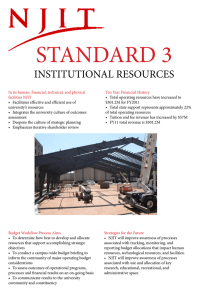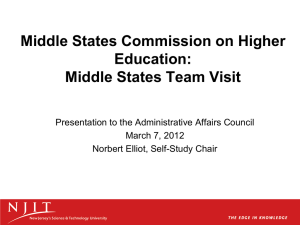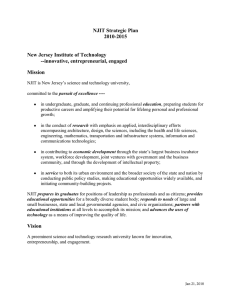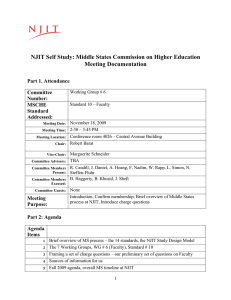Student Learning Assessment: Towards an Environmental Model for Academic and Student Services
advertisement
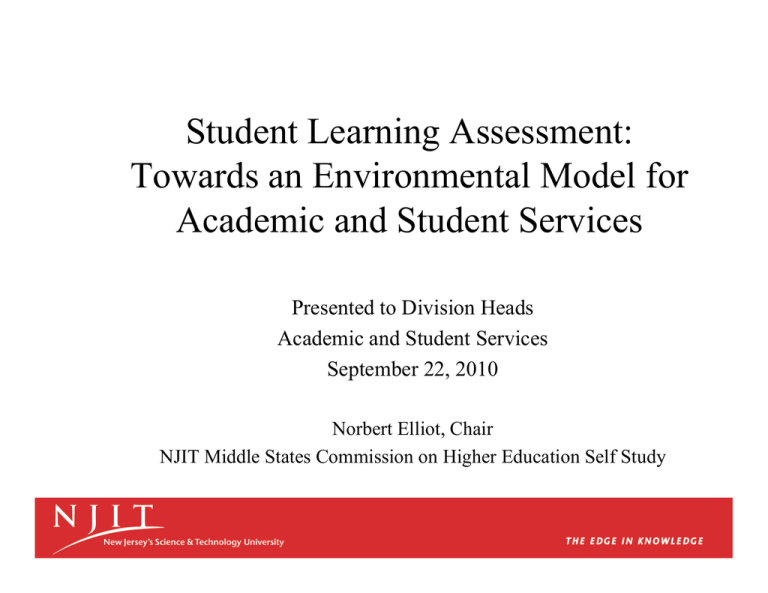
Student Learning Assessment: Towards an Environmental Model for Academic and Student Services Presented to Division Heads Academic and Student Services September 22, 2010 Norbert Elliot, Chair NJIT Middle States Commission on Higher Education Self Study Charge from Joel Bloom, Dean and VP for Academic & Student Services • Identify student learning outcomes in addition to those achieved in the classroom. • And, implicitly, design assessment methods that lead to documentation and improvement. MSCHE and Student Learning Assessment The NJIT Academic Affairs Institutional Level Learning Goals 1. 2. 3. An awareness of learning as a lifelong educational activity An attitude towards research-based inquiry An awareness of economic opportunity as integral to individual and community advancement 4. A call to service in a variety of community settings 5. An adoption of a leadership role in professional and citizenship activities 6. A disposition toward engagement within and beyond the NJIT community 7. A method of entrepreneurial inquiry when problem-solving 8. An application of technology to improve quality of life 9. An adoption of ethical conduct across circumstance 10. A view of diversity that celebrates cultural contexts 11. A sense of civility that embraces respect and candor The NJIT Academic Affairs Institutional Level Learning Goals The NJIT Academic Affairs Institutional Level Learning Goals for the General University Requirements The NJIT Core Competencies 1. 2. 3. 4. Student Engagement Writing, Reading, and Critical Thinking Quantitative Reasoning Information Literacy The Committee on Department and Program Assessment and the Subcommittee on Assessment • • • • • • • What is the cohesive framework of program assessment at NJIT? How are degree program and course goals integrated and articulated? How are learning outcomes tied to these goals? How have planned assessment processes been implemented? How do assessment results provide convincing evidence of student learning? How do program administrators use assessment in decision making? How have actions been taken as a result of assessment? • How have program assessment results been communicated to a variety of shareholders? The Role of Academic and Student Services • The need for an environmental validity model – Embrace a naturalistic environment – View validation as a unitary, procedural concept – Meet the needs of the present assessment community without compromising the ability of members of that community to meet their own programmatic needs – Acknowledge potential sacrifices in reliability that might yield greater construct relevance or increased construct representation – Stress that authentic assessment should improve authentic performance and yield insight into such performance, not merely audit it. The Process for Academic and Student Services: Step 1—Mapping The Process for Academic and Student Services: Step 2—Capture Existing Outcomes Through Environmental Audit The Process for Academic and Student Services: Step 3—(Re)Conceptualize the Model What are the demands of academic and student services, and how will these demands mediate the model? The Process for Academic and Student Services: Step 4—Select Documentary Method as Demonstration Vehicle • • • • • Benchmarking Formative Methods Summative Methods Indirect Methods Direct Methods The Process for Academic and Student Services: Step 5—Communicate Assessment Results The Web Site Tab The Podcast At Day’s End: Spring 2012 • What is your personal commitment to assessment? • How do you stimulate interest in assessment? • How do you support those who help the campus focus on assessment? • How do you provide the training to enable colleagues to strengthen assessment? • How do you encourage measurable outcomes of assessment endeavors? • How do you celebrate and reward assessment achievements?
